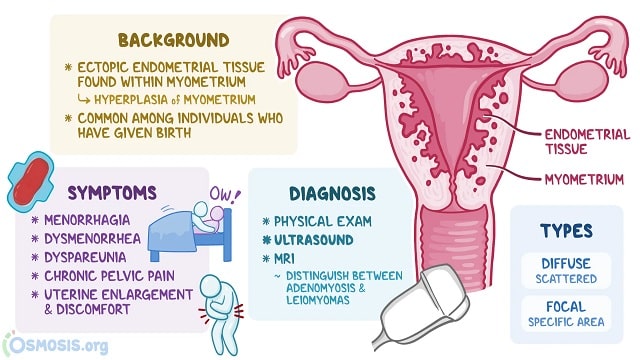Adenomyosis
Adenomyosis is a health problem in the female reproductive system. This condition causes the uterus to thicken and enlarge.
Endometrial tissue lines the inside of the uterus (endometrium). Adenomyosis, meanwhile, occurs when this tissue grows into the myometrium, the outer muscle wall of the uterus.
Extra tissue in the myometrium can cause the uterus to double or triple in size, as well as cause abnormal uterine bleeding and painful periods.
Symptoms of Adenomyosis
Sometimes adenomyosis causes no signs or symptoms, or only mild discomfort.
However, adenomyosis can generally cause symptoms such as:
- Heavy or prolonged menstrual bleeding.
- Severe cramps or sharp pelvic pain during menstruation (dysmenorrhea).
- Chronic pelvic pain.
- Painful sexual intercourse (dyspareunia).
- Menstruation is not normal.
- Infertility.
- An enlarged uterus characterized by tenderness or pressure in the lower abdomen.
Adenomyosis Risk Factors
Risk factors for adenomyosis include:
- Have had previous uterine surgery, such as a cesarean section, fibroid removal, or dilation and curettage.
- Childbirth.
- Middle-aged.
- Have a history of surgery to remove uterine fibroids.
- History of depression or use of antidepressants.
Most cases of adenomyosis are related to estrogen and occur in women aged 40-50 years.
Adenomyosis in these women may be related to longer exposure to estrogen compared to younger women.
However, current research suggests that the condition may also be common in younger women.
Causes of Adenomyosis
The cause of adenomyosis is not yet known for certain. However, experts suspect it is related to:
-
Invasive tissue growth
Some experts believe that endometrial cells from the uterine lining invade the muscle that forms the uterine wall.
The uterine incision that the doctor makes during surgery, such as a cesarean section, can encourage direct invasion of endometrial cells into the uterine wall.
-
Develops from the womb
Experts also suspect that endometrial tissue is deposited in the uterine muscle when the uterus first forms while the fetus is still in the womb.
-
Inflammation of the uterus associated with childbirth
Inflammation of the uterine lining during the postpartum period can cause the normal boundaries of cells lining the uterus to break down.
-
Stem cell origins
A recent theory suggests that bone marrow stem cells may attack the uterine muscle, causing adenomyosis.
But you need to understand, regardless of how adenomyosis develops, its growth depends on the body’s estrogen circulation.
Diagnosis of Adenomyosis
Doctors usually diagnose adenomyosis based on symptoms and with one or more of these tests:
-
Pelvic examination
During a pelvic exam, your doctor may notice whether your uterus has become larger or more painful to palpate.
-
Ultrasonography
Transvaginal ultrasound uses sound waves to produce images of the pelvic organs.
These images can sometimes show muscle thickening which raises suspicion of adenomyosis.
-
Magnetic resonance imaging (MRI) scan
This examination can show an enlarged uterus and thickening of certain areas of the uterus which can be an indication of adenomyosis.
-
Biopsy
Because the tissue grows inside the uterine wall, the only way to biopsy the tissue is after a hysterectomy, a surgical procedure to remove the uterus.
Adenomyosis Treatment
People with mild adenomyosis may not need medical treatment.
But if symptoms can interfere with daily activities and quality of life, your doctor may recommend the following treatment options:
-
Home treatment
Warm baths and hot compresses can help relieve adenomyosis symptoms.
In addition, you can also try exercise, meditation, or acupuncture. However, these treatments are only useful for mild adenomyosis.
-
Anti-inflammatory drugs
Anti-inflammatory drugs, such as ibuprofen, can reduce blood flow during menstruation while relieving severe cramps.
Your doctor may recommend that you take anti-inflammatory medications 2-3 days before your period and during your period.
-
Hormone treatment
Hormonal treatments can help control estrogen that may trigger adenomyosis symptoms. These include:
- Gonadotropin-releasing hormone (GnRH) analog.
- Oral contraceptives such as birth control pills.
- Progestin-only contraceptives, such as pills, injections, or intrauterine devices (IUDs).
-
Endometrial ablation
This treatment will focus on removing or destroying the endometrium. It is an outpatient procedure with a short recovery time.
However, this procedure may not be effective for everyone, as adenomyosis often affects deeper muscles.
Therefore, endometrial ablation is only recommended for people who are postmenopausal or who are not interested in getting pregnant.
-
Uterine artery embolization
This treatment aims to prevent certain arteries from supplying blood to the problem area.
By cutting off the blood supply, the adenomyoma shrinks. This procedure is commonly used to treat uterine fibroids.
-
Focused ultrasound surgery with ultrasound guidance
This procedure involves precisely focused high-intensity waves to create heat and destroy targeted tissue.
Meanwhile, heat is monitored using real-time ultrasound images. However, more research is needed on the effectiveness of this treatment.
-
Hysterectomy
The only way to completely cure adenomyosis is to undergo a hysterectomy. This surgical procedure involves the complete removal of the uterus.
Hysterectomy is a major surgical intervention and is only used in severe cases and in people who do not plan to have children in the future.
Adenomyosis Prevention
Because the exact cause is unknown, doctors don’t know what to do to prevent adenomyosis.
Complications of Adenomyosis
Heavy or prolonged bleeding due to adenomyosis carries a risk of causing chronic anemia.
This has the potential to lead to fatigue and other health problems.
Although not dangerous, pain and excessive bleeding due to adenomyosis can interfere with the sufferer’s activities.
They may avoid activities they normally enjoy, because of pain or worry about bleeding.
In addition, adenomyosis may also have an impact on fertility problems and a higher risk of pregnancy complications.

